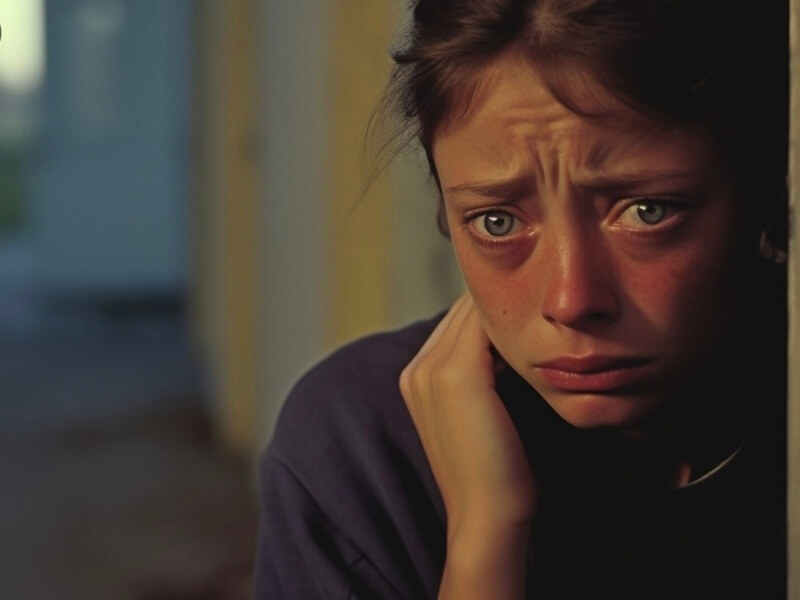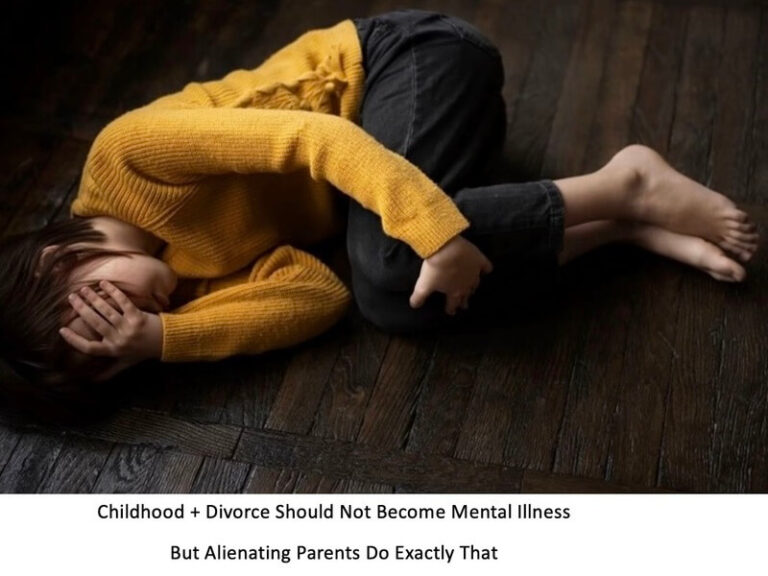Parental alienating behaviors are recognized in the psychiatric and scientific communities to be examples of “child abusive behaviors.” Peer-reviewed research and clinical literature document the profound, lifetime harm to alienated children from alienating behaviors.
When alienated children precipitously manifest psychiatric symptoms – as they invariably do – it is reasonable to presume the alienating parent to be the cause. Counterintuitively, however, the alienated parent is erroneously blamed.
The child psychiatrists who founded the family therapy movement in the 1950s coined the label “triangulation” for the dynamic that resulted in their child patients becoming psychotic. These psychiatrists determined that triangulating parents – another label for alienating parents – had caused their children’s psychosis.
Here you will learn:
- The 70-year recognition of the parental alienation phenomenon in child psychiatry and in family psychotherapy.
- The phenomenon of family triangulation – another label for parental alienation – spawned the birth of the family therapy movement in the 1950s.
- The psychiatrists who founded the family therapy movement determined that triangulating parents cause psychosis in their “triangulated children” – another label for “alienated children”.
- Clinical errors made by unqualified practitioners result in erroneous finding that alienated parents are the cause of their children’s psychiatric symptoms.

The Labels “Triangulation” and “Parental Alienation” Describe Identical Family Dynamics
Triangulation is another label for parental alienation. The family dynamics and family relationships occurring in each are interchangeable.
70 years of family therapy studies and clinical literature beginning in the 1950s describe dynamics in triangulation that are identical to the dynamics in parental alienation. Many of the terms discussed in both phenomena are exactly the same – such as favored parent, targeted parent, enmeshment, children being the “puppet” of their triangulating or alienating parent.
It is therefore justifiable to conclude that the family dynamics occurring in parental alienation were recognized in the psychiatric community dating back to the 1950s. It is also justifiable to conclude that the characteristics the child psychiatrists described about each parent in the triangulation dynamic are applicable to each parent in the parental alienation dynamic.
What Is Family Triangulation?

The family dynamic labeled “family triangulation” spawned the birth of the family therapy movement in the 1950s. The term “triangulation” was coined by child psychiatrist, Salvador Minuchin, the pre-eminent founder of family therapy movement, in consultation with other child psychiatrists.
These child psychiatrists initially observed the dynamics occurring in “triangulation” during their child patients’ visits with their families. The reason to observe the family visits arose after the psychiatrists noted that their child patients had improved on the psychiatric wards but regressed after family visits.
The following sequence of interactions were the observed during the family visits:
The parents became embroiled in an unresolved, mean-spirited dispute with each other.
The parent who was subsequently labeled the “favored” or “triangulating” parent co-opted the child into becoming an ally in the parental dispute. The relationship between the triangulating parent and child was labeled “enmeshment.”
Dr. Minuchin coined the word “enmeshment.” He did not precede it with “pathological” because he believed all enmeshed relationships were pathological.
The triangulated child was coerced and manipulated by the triangulating parent to support and contribute to that parent’s denigration and marginalization of the “targeted” other parent. Once aligned, the triangulating parent became the “favored” parent.
The triangulating parent’s co-opting maneuvers had created a no-win, double-bind dilemma for the child.

The child’s only resolution to the dilemma was a choice between two bad options —neither of which would allow the child to preserve a relationship with each parent.
If the child aligned with the triangulating parent, the relationship with the targeted parent became impaired. If the child refused to align, the triangulating parent would reject the child due to “perceived” disloyalty.
Family psychotherapy maintains that insanity or psychosis results from double-bind/no-win situations – like the one created by the triangulating parent for the triangulated child.
Dr. Minuchin and his colleagues deemed “triangulation” to have caused their child patients’ psychosis.

FURTHER READING: Parental Alienation: Truth Revealed by an Expert
What Family Therapy Psychiatrists Said About the Link Between Triangulation & Child Psychosis
Jay Haley (1977) Describes “The Perverse Triangle”
“The people responding to each other in the triangle are not peers, but one of them is of a different generation from the other two… In the process of their interaction together, the person of one generation forms a coalition with the person of the other generation against his peer.
By “coalition” is meant a process of joint action which is against the third person… The coalition between the two persons is denied. That is, there is certain behavior which indicates a coalition which, when it is queried, will be denied as a coalition…
In essence, the perverse triangle is one in which the separation of generations is breached in a covert way. When this occurs as a repetitive pattern, the system will be pathological…
A parent-child coalition not only undermines the authority of the other parent but makes the authority of the favoring parent dependent upon support from the child.” (pp. 31-48)
Child Psychiatrist Murray Bowen Discusses the Harm to the Child from Triangulation

Dr. Bowen was convinced that his child patients’ psychosis is caused by the triangulation dynamic. When Dr. Bowen hospitalized the child, he consequently hospitalized the child’s entire nuclear family. Dr. Bowen did not believe a child would be able to unilaterally escape from the enmeshed relationship with the triangulating parent.
Dr. Bowen (1971) describes the clinical presentation of the triangled child:
“The problem of the triangled child presents as one of the most difficult problems in family psychotherapy… in the severe triangling or projection of the parental problem to the child, the parents are not able to leave the child out of their feelings, thoughts, and actions…. Life itself is invested in the child.” (P. 190)
Dr. Bowen (1978) describes the harm to the triangulated child from the evolving triangulation process:
“As patterns repeat and repeat in a triangle, the people come to have fixed roles in relation to each other. The best example of this is the father-mother-child triangle. Patterns vary, but one of the most common is the basic tension between the parents….
The mother wins over the child, who moves another step closer toward chronic functional impairment. The pattern is described as the family projection process. Families replay the same triangular game over and over for years, as though the winner were in doubt, but the final result is always the same.
Over the years the child accepts the always-lose outcome more easily, even to volunteering for this position.” (pp. 199-200)
Child Psychiatrist Salvador Minuchin Describes the Severe Symptoms Resulting to the Child from Triangulation

Dr. Minuchin (1978):
“In the first two patterns, triangulation and parent-child coalitions, the spouse dyad is frankly split in opposition or in conflict, and the child is openly pressed to ally with one parent against the other. In triangulation, the child is put in such a position that she cannot express herself without siding with one parent against the other. In a parent-child coalition, the child tends to move into a stable coalition with one parent against the other.” (p. 33)
Dr. Minuchin (1972):
“The rigid triangle can also take the form of a stable coalition. One of the parents joins with the child in a rigidly bounded cross-generational coalition against the other parent….Whenever the child sides with one, he is automatically defined as attacking the other.

In this highly dysfunctional structure, the child is paralyzed. Every movement he makes is defined by one parent as an attack….This triad is the typical transactional pattern, accompanied by other significant family characteristics, in families having children with severe psychosomatic symptoms.” (p. 102)
Dr. Minuchin (1981) metaphorically labeled the triangulated child as the “puppet” of the triangulating parent (p. 135). Dr. Richard Gardner (2001), who first coined the label Parental Alienation Syndrome (PAS), metaphorically labeled the alienated child as “just-a-parrot (puppet) of the alienating parent (pp. 112-113).
For both Dr. Minuchin and Dr. Gardner, whenever the triangulated/alienated child’s lips move, the words from the triangulating/alienating parent’s mouth are emitted.
Dr. Minuchin describes one of his treatment cases in which the triangulating process had ensnared the child in the role of “puppet” to the triangulating parent:
“The therapist can posit, at this point, that the daughter is supported by the father or grandmother, or is in a collation with both against the mother. By maintaining the focus of the mother-daughter conflict beyond its usual threshold, the therapist highlights the position of the daughter as a puppet in the midst of a complex conflict.” (p 135)
Dr. Minuchin intervenes to expose for the family the triangulation process that is maintaining the child symptoms in the role of “puppet”:
“You are saying to your mommy the kind of things that you know your grandma and your father say to your mother. So you are just the voice of everybody in the family. You don’t have your own voice. You are the puppet of the ventriloquist. Have you ever seen a ventriloquist?
Sit on your mother’s lap…Now tell your mother the way in which she should change, thinking like your grandmother.” (p. 138)
Dr. Minuchin (1981) discusses the potential harm to the child from enmeshment with the triangulating parent:
When they must function as autonomous entities, they may face a serious crisis. When the children reach late adolescence and must begin to separate from the family, psychotic breaks and psychosomatic illness can occur. (P. 142.)

Dr. Minuchin (1978) elaborates on the harm to the child from enmeshment with the triangulating parent:
“Enmeshment refers to an extreme form of proximity and intensity in family interactions. It has implications at all levels: family, subsystem, and individual. In a highly enmeshed, overinvolved family, changes within one family member or in the relationship between two members reverberate throughout the system….
Subsystem boundaries in enmeshed families are poorly differentiated, weak, and easily crossed…. When boundaries are crossed, children may act inappropriately towards parents or siblings. Or a child may join or be enlisted by one parent against the other in decision making.” (p. 30)
Child psychiatrist Nathan Ackerman Describes the Triangulation Process That Created Psychosis in His Child Patient
Dr. Ackerman was mentor to Dr. Minuchin. Here I provide an example of the profound harm to the triangulated child as reflected in Dr. Ackerman’s often-cited “Queendom” case.
In the “Queendom” case, a delusional a girl believed she was living on another planet called “Queendom.” Queendom is inhabited only by women. The family composition included the parents and the overempowered maternal grandmother, who was enmeshed with her daughter, the girls’ mother and wife to the girl’s father.
An alignment of grandmother/mother/daughter disempowered the girl’s father, who became disengaged from his wife and from his daughter. Dr. Ackerman reframed the girl’s delusional fantasy to symbolize the family’s dysfunctional organization, and he characterized the girl’s delusional symptoms as serving the purpose of re-uniting her parents as couple.

FURTHER READING: Parent Alienation and Child Psychological Abuse in the DSM-5
Family Psychotherapy & the Triangulated or Alienated Child’s Psychiatric Symptoms
The above cited references are the tip of the iceberg of 70-years of knowledge produced by family therapy research and the clinical literature. The inescapable finding of these 70 years of knowledge is that the favored or triangulating/alienating parent is cause of the children’s psychosis.
Furthermore, there are no peer-reviewed research studies – let alone a 70-year history of knowledge – that found targeted (alienated) parents to be the cause of their children’s psychiatric conditions.
Mistakes That Compromise Parental Alienation Findings by Unqualified Practitioners
The standards of clinical practice require that the scientific method be relied upon to make findings. This requirement is so much more imperative given that alienation cases are exceedingly complex and counterintuitive. As Dr. Miller states:
“Few mental health problems are more difficult to sort out or more resistant to treatment than the triad of a severely alienated child, a severely determined alienating parent, and a severely rejected targeted parent…Cases of severe alienation are likely to be highly counterintuitive. Clinicians who attempt to manage them without adequate skills are likely to find themselves presiding over a cascade of clinical and psychosocial disasters.”
The scientific method to make clinical findings is beyond the scope of this article. I will, however, summarize the commonly violated clinical axioms resulting in erroneous findings in an alienation cases. These violations contribute to why alienated parents are erroneously blamed for having caused their children’s psychiatric symptoms.
FURTHER READING: Clinical Reasoning and Decision Making in Cases of Child Alignment

Failure to Consider the Total Clinical Picture
Consideration of the “total clinical picture” is the single most important clinical axiom. It is particularly relevant to alienation cases given the complexity and counterintuitive nature of alienation.
The axiom to “consider the clinical picture” means to evaluate the clinical presentation in its historical context. Doing so provides the clinician with a basis of comparison between the clinical picture before and after the manifestation of the patient’s symptom(s). This is known as patient’s “base rate.”
Compliance with this axiom is the reason why physicians ask new patients for their medical history before a diagnosis and treatment can be determined for the presenting clinical problem.
Non-specialists in alienation invariably fail to comply with this clinical axiom. For example, they do not adequately explore the nature and quality of the relationship between the alienated parent and child prior to the onset of the child’s manifestation of psychiatric symptoms.
A red-flag of suspicion should spring up when hundreds of photographs and videos reveal a loving, close, and meaningful relationship between the alienated parent and child up to the moment that the child’s psychiatric symptoms emerged.
In compliance with the clinical axiom to “consider the total clinical picture,” the following questions require an answer:
- What is the explanation for why alienated children, who had been functioning normally prior to the onset of the alienation, suddenly develop psychiatric symptoms?
- What accounts for the protracted delays between when alienated children manifest psychiatric symptoms and when their alienated parent had allegedly done something to cause the symptoms?
- What explains why alienated children and their alienated parent continue to have meaningful contact for a protracted time after that parent had allegedly done something to cause the child to manifest psychiatric symptoms?
- Is there a connection between the initiation of adversarial custody proceedings and alienated children’s belated development of psychiatric symptoms?
- What role might alienating parents play in the timing to the initiation of custody proceedings of alienated children’s manifestation of psychiatric symptoms?
- How is it possible for alienated parents to have been the cause of their children’s psychiatric symptoms in the absence of contact with their children?

Non-specialists in alienation invariably violate the axiom to “consider the total clinical picture” when they blame alienated parents for having caused their child’s psychiatric conditions.
FURTHER READING: Assessing Parental Alienation Using the Scientific Method
Failure to Undertake a Causal Analysis
For something to have been the cause of something else, it must have preceded the dependent effect.
When alienated parents are erroneously blamed for having caused their children’s psychiatric symptoms, a contributing factor is the failure to have undertaken a causal analysis to establish that. Alienated parents are incredulously blamed even in situations in which they have not had contact with their children for many months, if not for years.
In other circumstances, the alienated parent’s alleged causal behavior for the child’s psychiatric symptoms had occurred well prior to ongoing, wonderful contacts.
The claim that the alienated parent had caused the child’s psychiatric symptoms is suspiciously made subsequent to the initiation of contentious custody proceedings. Astonishingly, no one considers blaming the alienating parent, who typically has virtually exclusive – if not exclusive – caretaking and control of the child.

Unjustified Reliance Upon Fallible Intuitive Reasoning
Non-specialists in alienation typically accord the alienating parent and alienated child unjustified credibility that they are reporting accurately and truthfully. It is not questioned that the self-interested reporting of alienating parents and of brainwashed children may be tainted.
When this occurs, non-specialists are violating the clinical axiom to “use proper reasoning.”
The clinical axiom to “use proper reasoning” requires that findings and opinions must be based upon a combination of intuitive reasoning and analytical reasoning – specifically that findings based upon intuitive reasoning be corroborated with analytical reasoning.
Intuitive reasoning is one’s gut reaction to or instinctual judgment about something. Analytical reasoning is objective, reasoned evaluation of quality evidence. We are familiar with the adage, “self-reporting is unreliable.”
No one thinking rationally would take seriously the findings of a physician who had relied exclusively upon the patient’s self-diagnosis of the medical condition. How long does one think an emergency room doctor would retain that position if she or he relied exclusively or primarily upon patient’s self-report of symptoms?
For example, an ER doctor would be committing medical negligence if she or he treated a patient with a handful of Prilosec based solely upon the patient’s insistence that the indigestion and heartburn symptoms being experienced were not signs of a heart attack but instead had been caused by the rotten fish eaten for lunch?
Non-specialists in alienation are as negligent as this ER doctor would have been by relying exclusively upon the patient’s self-report about symptoms. Yet, non-specialists rely virtually exclusively- if not exclusively – upon the brainwashed, alienated child’s reporting is rampart in alienation cases.
Failing to comply with the clinical axiom to “use proper reasoning” is a major contributing factor for the erroneous claim that alienated parents are the cause of their child’s psychiatric symptoms.
Further Reading: Current Status and the Future Prospects of Clinical Psychology
Failure to Rule Out for Suggestibility of the Child
Humans are suggestible, which compromises the reliability of even adult self-reporting. Children, whose cognitive development is immature, are more vulnerable than are adults to suggestibility. (See Bruck & Cici, 1999 & 2002; Loftus, 1997, 2002).
The reporting of alienated children is exceptionally compromised due to the brainwashing by their alienating parent. We have extensive research on the suggestibility of children and the ease with which false memories can be implanted in them.
Before credibility is given to an alienated child’s reporting about any of the family dynamics, an evaluation must be undertaken to rule out for suggestibility by the alienating parent.
Failure to Assess for Lying and Deception

Lying and deception come naturally to humans. These are holdover skills from cave-person days and still reside in our survival tool kit. Children are storytellers. What parent has not had to teach their child not to lie?
Alienated children’s innate survival skills of lying and deception are enhanced by schooling from their alienating parents. Alienating parents are experts in impression management and in mimicking normal behavior. This is due to the likelihood of having one or more personality disorders.
It is therefore extremely difficult to determine when alienated children are lying or telling the truth. They sound exceedingly credible even when reporting the most egregious lies about their alienated parent.
Humans are Poor Lie Detectors
Humans are poor lie detectors. Research shows we can distinguish when someone is reporting a lie from reporting the truth only 54% of the time.
This fallibility in being able to distinguish truth from lies contributes to the credibility that is given to alienated children’s egregious lies about their alienated parents including that their alienated parent had caused their psychiatric symptoms.
This fallibility further accounts for why alienated children appear so credible and truthful even when telling the most egregious lies about their alienated parent.
Conclusion
The dynamics that occur in parental alienation are identical to the dynamics that occur in family triangulation. Triangulating parents were found by child psychiatrists in the 1950s to have caused psychosis in their triangulated children.
Given this 70 year history in family psychotherapy documenting the dangers to children from triangulating/alienating parents, time is of the essence to protect children from these parents. Remedy must be imposed according to child protection standards – removal from incorrigible triangulating, alienating parents.
REFERENCES
Ackerman, N. & Frankin, P. (1965). Family dynamics and the reversibility of delusional formation: A case study in family therapy, in I. Boszormenyi-Nagy & J. Famo (Eds.), Intensive family therapy. New York, NY: Harper, Chapter 6.
Bowen, M. (1971). The Use of Family Theory in Clinical Practice. In J. Haley (Ed.), Changing families: A family therapy reader. New York: Grune & Stratton, 159–192.
Bowen, M. (1978). Family therapy in clinical practice. New York: Jason Aronson
Bruck, M. & Ceci, S. (1999). “The Suggestibility of Children’s Memory.” Annual Reviews of Psychology. (50): 419-439
Bruck, M., Ceci, S., & Hembrooke, H. (2002). “The Nature of Children’s True and False Narratives,” Developmental Review. (22): 520-554.
Gardner, R. A. (1998). The parental alienation syndrome (2nd ed.). Cresskill, NJ: Creative Therapeutics.
Gardner, R. A. (2001). Therapeutic interventions for children with parental alienation syndrome. Cresskill, NJ: Creative Therapeutics.
Haley. J. (1977). Toward a theory of pathological systems. In P. Watzlawick & J. Weakland (Eds.), The interactional view, New York, NY: Norton: 31-48.
Loftus, E. (1997). “Creating False Memories.” Scientific American. 277 (3): 70-75.
Loftus, E. (2000). “The Dangers of Memory.” Academia.edu. Online 105-117.
Minuchin, S. (1974). Families and family therapy. Cambridge, MA: Harvard University Press.
Minuchin, S., Baker, L., & Rosman, B. (1978). Psychosomatic families: Anorexia nervosa in context. Cambridge, MA: Harvard University Press.
Minuchin, S. & Fishman, C. (1981). Family therapy techniques. Cambridge, MA: Harvard University Press.


